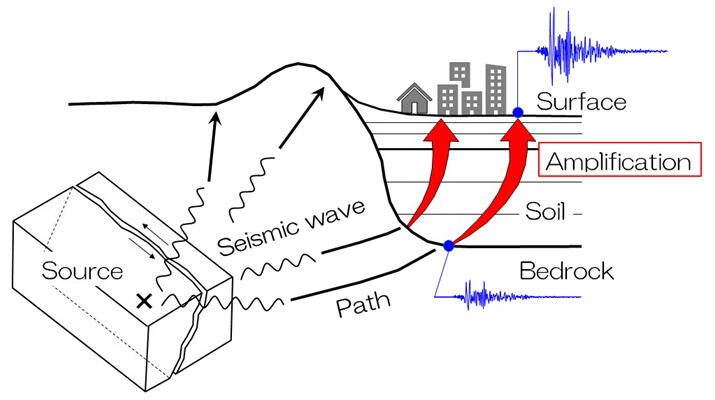A research group including Professor Hiroyuki Miura of Hiroshima University's Graduate School of Advanced Science and Engineering, in collaboration with Retrofit Japan and Aioi Nissay Dowa Insurance Co., Ltd., announced on June 28th that they have developed a technology to simplify the indexing of the seismic hazard of the ground and structures using micro vibrations called microtremors. Vibrations of the ground and structures are measured and analyzed using AI technology on a computer to quantitatively evaluate safety during earthquakes within tens of minutes to an hour. With regard to the results, a patent application has been filed (application number: Patent Application No. 2024-072242) as "Seismic hazard evaluation device, seismic hazard evaluation method and program."

Provided by Hiroshima University
The magnitude of ground shaking caused by earthquakes is greatly influenced by the properties of the ground near the surface, and areas with thick deposits of weak ground will experience considerable shaking during earthquakes. In addition, each structure has its own period where it is prone to swaying (natural period). This means that the seismic swaying of medium- and high-rise structures such as buildings differs even on the same ground according to their construction and height. In particular, when the natural frequency of the structure and ground coincide, a resonance state may occur that increases the shaking of the structure, thereby increasing the hazard. However, there has been no indicator that shows whether the concerned structures are prone to resonance during earthquakes.
In response to this, the research group has developed a simple index to express ground shaking and structure resonance susceptibility based on microtremor data of the ground and buildings. Specifically, the ground amplification ratio is estimated from ground microtremor data using spectral analysis and AI technology proposed by Miura and his colleagues. The estimated peak frequency and peak value of ground amplification factor are used to calculate the index value, Kg, for ground shaking susceptibility. Kg values are larger for weaker and thicker grounds.
For determining structure resonance susceptibility, microtremor data for the bottom and top floors of the building and the surrounding ground are used to determine the natural frequencies of the building and ground using spectral analysis. From these values, an index R value representing resonance susceptibility is calculated. The closer the natural frequencies of the structure and ground are to each other, the larger the R value becomes, particularly for high-rise buildings (buildings with a long natural period) where the effect of resonance tends to be more significant.
Using these index values, it is now possible to quantitatively evaluate the seismic hazard of the ground and structure in an effortless manner within a short period. The measurement time is approximately 10-60 minutes, and the time required for analysis may be as short as 10 minutes. Kg and R values were calculated from the measurement results of a mid-rise building in Sendai City and a skyscraper in Osaka City, which were severely damaged by the 2011 Great East Japan Earthquake, mainly due to resonance effects. The values were extremely large, which confirms the effectiveness of the developed indexes.
In the future, the research group plans to increase the number of measurement cases and investigate the characteristics of Kg and R values for each region and structure and will consider a method to determine an index for the overall seismic hazard at a target location.
Miura said, "The method we proposed this time is a kind of health checkup for the ground and structures, so to speak, and is a simple way to evaluate seismic hazard. The basic principle of disaster prevention is, as Sun Tzu said, 'If you know the enemy and know yourself, you need not fear the result of a hundred battles.' Firstly, it is important to know the seismic hazard around you. We hope that by studying the characteristics of the ground and structure around us through this method, we can begin to think about seismic diagnosis and reinforcement, and other disaster prevention measures against future earthquakes."
This article has been translated by JST with permission from The Science News Ltd. (https://sci-news.co.jp/). Unauthorized reproduction of the article and photographs is prohibited.




